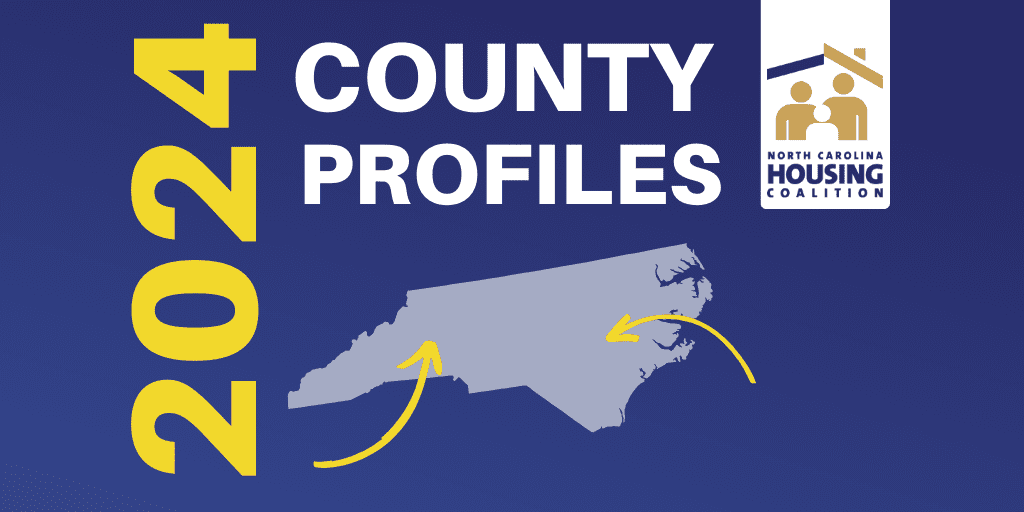
Earlier this year we released our County Profiles (which now includes a profile for the State of North Carolina). Our County Profiles are meant to provide a snapshot of housing needs in each county, and to provide data on a few key indicators that can help everyone from community organizers to elected officials discuss the housing needs and potential solutions in their community. Here are two of the main tips we typically give on how to effectively use and communicate the data in the County Profiles.
Tip #1: Check out the Profile not only for your county, but the counties surrounding it.
One of the best ways to see the scale and scope of the housing need in our state is to look at the communities around us. Often times it’s easy for people to assume housing need is only in certain areas, but if you look at any number of the 100 County Profiles, you’ll see that in every county there is cost burden (people paying more than 30% of their gross income on housing). You’ll also see that there is no county in North Carolina where someone earning the minimum wage can afford an apartment at Fair Market Rent (FMR).
Tip #2: Find County Profiles from the past and compare that profile to the most recent one.
Reach out to any member of our policy team or to info@nchousing.org and ask for last year’s edition of the County Profile for your county or even profiles from prior years (they go back to about 2016). Then look at the 2024 Profile in comparison to the previous years, and ask yourself the following questions:
- How have things changed?
- Have things improved? Or has it gotten worse?
- What data points stand out?
The answers to these questions are good to ask of other advocates and elected officials, but they are also good next steps for any housing research you’re doing as well.
Tip #3: Make sure you can connect to why these data points matter.
It is fairly easy to just read data off of a piece of paper or PowerPoint, but let’s dig into why these data points matter.
Cost Burden – Cost burden is an indicator that both the cost of living is high AND that income is not keeping up. At the top of each County Profile, the cost-burdened percentage applies to all renters and homeowners in that county. A good portion of members of your community are paying more than they should on housing, and in some cases more than they are able. If people are spending more money on housing, they have less money for food, healthcare, childcare, transportation, and other critical day-to-day life expenses. Cost burden is a slippery slope that can put people at risk of housing instability and, in worst cases, homelessness.
Average Annual Salaries vs. Fair Market Rent + The Housing Wage vs. Fair Market Rent
At the Coalition, one of the ways we try to advance the belief that “housing is a human right” is by shifting the narrative. A pervasive myth is that housing affordability is a result of individuals’ personal financial decisions. But when we look at average annual salaries compared to Fair Market Rent, it’s clear the housing need is much more systemic, and much bigger, than personal financial responsibility.
The average annual salaries we highlight are those of an elementary school teacher, a child care worker, and a firefighter. In most counties across the state, none of their average salaries allow them to afford a 2-bedroom apartment at Fair Market Rent.
And the Fair Market Rent – which is a measure created by HUD to determine what should be appropriate for a particular market – doesn’t always capture the real on the ground market rents, meaning the rents in an area are usually much higher, This means affordable housing is often even further out of reach for teachers, childcare workers, firefighters, and many other workers across different industries.
The Housing Wage is the hourly wage needed to afford a 2 bedroom apartment at Fair Market Rent in each county. These Housing Wages were developed by the National Low Income Housing Coalition (NLIHC) and can apply to both hourly and salaried workers.
As we mentioned earlier, nowhere in the state can someone earning minimum wage afford a 2 bedroom apartment at Fair Market Rent. The Housing Wage in our counties are often double and triple the federal minimum wage, meaning members of our communities have to work 120+ hours or at least 2.5 jobs to afford their home, let alone other expenses.
This tool is one one part of your toolkit
Use these data points to highlight that the need for affordable housing is widespread, and it is a systemic issue requiring systemic and creative solutions.
No one knows their community better than those living and experiencing life in it. This tool is only one of many resources that you can have in your toolkit to discuss or explain to others the scale and urgency of the affordable housing need in your county. Use your County Profile to get the conversation going, to showcase how widespread this issue is, and to stress the importance of understanding that the housing crisis is a systemic problem we can all play a role in addressing and fixing, especially if we begin to see housing as it should be, a human right.








